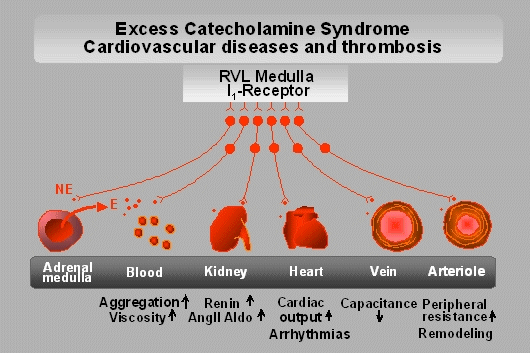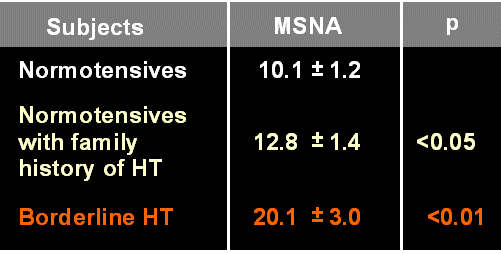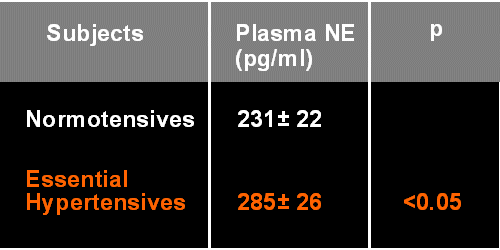Sympathetic
overactivity
and hypertension
A raised sympathetic activity results
acutely in an increased peripheral resistance (alpha-1 adrenergic
receptors)
and cardiac output via a higher heart rate (beta-1 receptors). A
reduced
venous capacitance contributes to this rise in blood pressure. Such an
acute rise in blood pressure was required in previous centuries when a
fight-flight situation or blood loss occurred.
A close relationship
between a rise in sympathetic activity and body weight increase can be
derived also from the findings that younger hypertensive persons
exhibit
an increased cardiac output, while the peripheral resistance is still
greatly
normal. With increasing age, manifestation of high blood pressure
occurs
that is based on a progressive increase in peripheral resistance and a
gradual normalization of cardiac output. Since both, an increase in
cardiac
output and peripheral resistance can result in high blood pressure, the
traditional blood pressure recording does not provide information on
this
critical time-course of hypertension development.
When sympathetic
activity
is raised over a prolonged period of time, remodeling of the arterioles
occurs involving also media hypertrophy. The media hypertrophy leads to
an overproportional constriction of the vessel lumen and thereby
amplifies
the peripheral resistance.

The concept that a raised sympathetic
activity
is crucial particularly during early progression of hypertension is
supported
by the findings that borderline hypertensive patients exhibit a higher
sympathetic activity in skeletal muscle:

Mancia et al. J Hum Hypertens 1997;
11(suppl
1): S3-S8
Maintenance of hypertension is also
associated
with higher plasma norepinephrine levels as observed in patients with
"essential
hypertension":

Mancia et al. J Hum Hypertens 1997;
11(suppl
1): S3-S8
The term "essential hypertension" or
"primary
hypertension" implicates that the cause of hypertension is not known.
In
the case of overweight persons, the term "essential hypertension" is
misleading
since the raised sympathetic activity is a crucial factor contributing
to the "overweight hypertension". Based on these pathophysiological
mechanisms, moxonidine which reduces sympathetic outflow of the brain
is rated as choice of drug in overweight or obese subjects.



